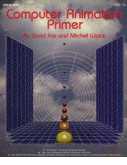By David Fox and Mitchell Waite, published 1984

Table of Contents (brief | detailed) |
Cover
Title page
Library of Congress Cataloging Information
Authors' dedication
Table of Contents
Preface
Acknowledgments
CHAPTER 1: Animation Perspectives
1.1: Welcome to Computer Animation
1.2: Our Premise
1.3: About The Book
1.4: What Is Animation?
1.5: What is Computer Animation?
1.6: A Little History of Animation
1.7: How is Computer Animation Used Today?
1.8: Getting Started in Animation Today
CHAPTER 2: Computer Animation Hardware
2.1: The CRT Canvas
2.2: Stroke Graphics
2.3: Raster Graphics
2.4: The Graphics Computer - A First Look
2.5: The Bit and The Pixel
2.6: Adding Gray Scale
2.7: Adding Color to The Display
2.8: Frame Buffers
2.9: Getting The Frame Buffer Image On Film
2.10: Encoding The Picture In The Buffer
2.11: Color Mapping
2.12: Video Mixing Via Bit Planes
2.13: Other Encoding Techniques
2.14: Advanced Graphics Hardware
2.15: Personal Computer Graphics Hardware
2.16: Color In The Personal Computer
2.17: Memory-Mapped Video and Text Storage
2.18: Character Graphics
2.19: Graphics Peripherals
CHAPTER 3: Computer Animation Software And Applications
3.1: Graphics Software - The Basics
3.2: Transformations
3.3: Clipping and Windowing
3.4: Fills and Scan Conversion
3.5: Three-Dimensional Representations
3.6: Curves and Surfaces
3.7: Hidden Line and Surface Removal
3.8: Shading
3.9: Antialiasing Lines
3.10: Personal Computer Animation Software
3.11: High-Tech Digital Paint Systems
3.12: Computer-Assisted and Computer-Generated Animation
3.13: The Making of TRON
3.14: An Animation House - Examples
3.15: An Apple for Animation - James Leatham
CHAPTER 4: Personal Computer Animation Features
4.1: Format of This Chapter
4.2: BASIC Graphics Statements
4.3: Special Hardware Features
4.4: Graphics and Text Modes
4.5: Graphics Language Statements
4.6: Players and Sprites
4.7: Hardware Scrolling
4.8: Graphics Characters
4.9: Custom Character Sets
4.10: Color Registers
4.11: Vertical Blank Interrupts
4.12: Display Lists and Display List Interrupts
4.13: Speed of Plotting
CHAPTER 5: Character Set Animation
5.1: Built-in Character Sets - Making Do with What You Have
5.2: User-Defined Character Sets - A Bouncy Walking Man
5.3: Flipping Character Sets - The Galloping Horse
5.4: Exploding with a Three-Color Character Set
CHAPTER 6: Color Register Animation
6.1: Why Color Registers?
6.2: Creating Motion with Color Registers
6.3: The Trench Program
6.4: Autumn Waterfall Program
CHAPTER 7: Player-Missile Graphics
7.1: Why Player-Missile Graphics?
7.2: Player Motion
7.3: Player Parameters
7.4: Watch the Bouncing Ball - Using PM Graphics
CHAPTER 8: Using Machine Language Routines in BASIC Programs
8.1: What is Machine Language?
8.2: Moving Players with PMOVER
8.3: Automatic Animation with ANIMATE
8.4: Setting a Horizontal Velocity with AUTOMOVE
8.5: Player Foreground for the Great Movie Cartoon
CHAPTER 9: Creating A Scrolling Background
9.1: The Display List Revised
9.2: The Scrolling Background Program
9.3: The Great Movie Cartoon
APPENDICES
A: Complete Listings of BASIC Program Examples
B: Character Set Grid/ATARI ROM Character Set
C: Listing Conventions
D: The String Loader Program
E: Complete List of Parameter Table Entries for Black Box Routines
F: Source Code Listings of Assembly Language Routines
G: ATARI Hardware and Shadow Registers
H: Graphics Memory Map Modes
Table of Contents (brief | detailed) |
You may be able to buy a pre-owned, printed copy of the book from amazon.com.
This site maintained by Kay Savetz.Computer Animation Primer is copyright © 1984 by David Fox and Mitchell Waite, and is posted on www.atariarchives.org
with permission. Do not redistribute, mirror, or copy this online book. You can contact David Fox at David@electriceggplant.com.

